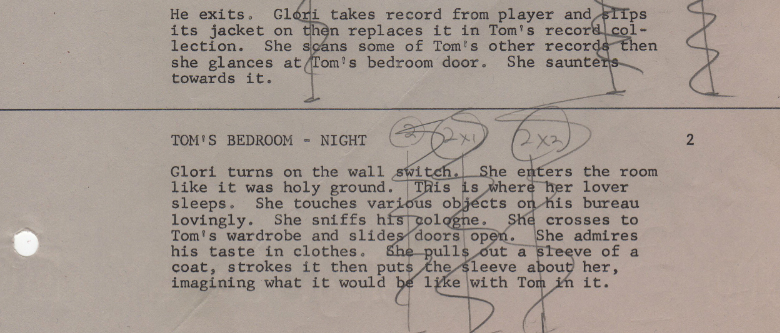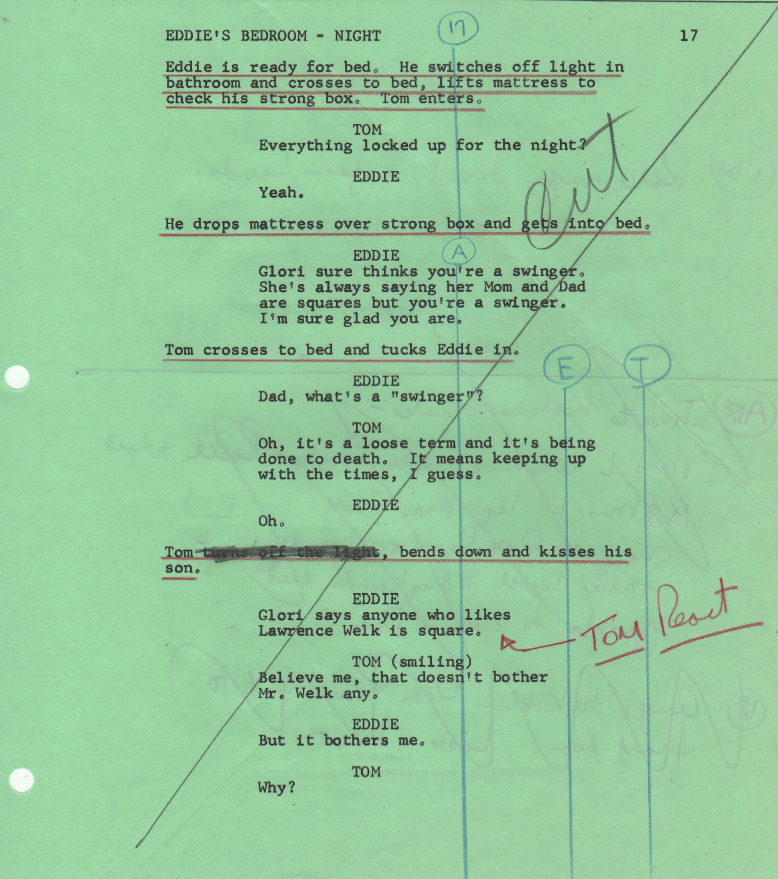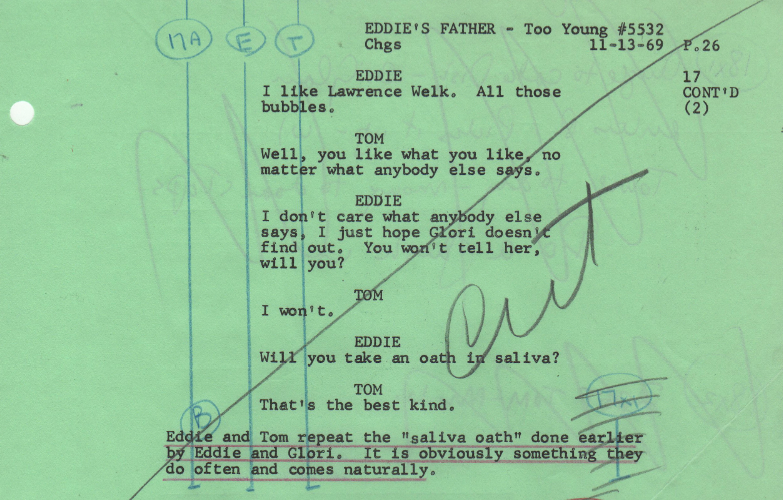FILMED November 1969
In November I reported back to MGM to prep the first of a four-picture commitment for THE COURTSHIP OF EDDIE’S FATHER, this one a romantic comedy. The romantic triangle had been a staple of cinema for eons. Joan Crawford made a career of having to decide which of two attractive leading men she would end up with in the final clinch: Clark Gable or Robert Montgomery in FORSAKING ALL OTHERS, Melvyn Douglas or Robert Young in THE SHINING HOUR, Robert Young or Franchot Tone in THE BRIDE WORE RED, Franchot Tone or Clark Gable in LOVE ON THE RUN. Claudette Colbert had a similar problem: Fred MacMurray or Ray Milland in THE GILDED LILY, Ray Milland or Brian Aherne in SKYLARK. And Ingrid Bergman in that classic of classics — CASABLANCA — had to choose between Humphrey Bogart and Paul Henreid. There was a variation on that plot: Man A wants and pursues Woman who in turn wants and pursues Man B. That was the formula in the greatest romance of them all — GONE WITH THE WIND, where Clark Gable’s Rhett Butler chased Vivien Leigh’s Scarlett O’Hara, who pined for Leslie Howard’s Ashley Wilkes. Why do I bring this up? Well that was the basic plot of my next COURTSHIP. So after the opening Peanuts-style intro, come meet two of the three corners of our intriguing love triangle.
As you can see, Glori is going to be our Scarlett O’Hara. But who is going to be our Rhett Butler?
When directing a play, the several weeks devoted to rehearsals provided the time to experiment, to make changes in the script, to alter conceptions for staging as envisioned by the author. Television did not provide that luxury, so many changes were made minutes before the director called, “Action.” Here’s a short scene from the script followed by the scene, with some changes made, as filmed.

A jacket on a jacket rack was much more accessible than a jacket hanging in the closet. I remember Peggy Chantler Dick, the series Type Righter, being especially excited by this sequence when we viewed it in dailies. In the script the prologue did not end there; it continued with Glori dashing into the living room, picking up the newspaper as Tom entered, but this was too good a moment to pass up for the fadeout, so Glori enfolded in the arm of Tom’s jacket became the ending for the prologue. And it sure looks like Tom is going to be our Ashley Wilkes.
And there’s our cast: Rhett Butler (Eddie) plans to marry Scarlett O’Hara (Glori) who dreams of Ashley Wilkes (Tom).
According to the IMDB (Internet Movie Data Base) this was (surprisingly) Sherry Lynn Diamant’s first film role. She made two more screen appearances and then disappeared from the profession for nineteen years, when she made one more film
It seems our Scarlett was just as devious as the original Miss O’Hara. Fortunately our Scarlett didn’t require a green velvet gown made out of the draperies. Carol Burnett’s television budget could include it; ours couldn’t.
Children actors interest me, not the precocious little darlings with the pushy soundstage mothers, but kids like Brandon who brought great realism to their work before the camera. There have been major children film stars: Shirley Temple, Margaret O’Brien. Some who continued and had major careers as adult performers: Mickey Rooney, Judy Garland, Elizabeth Taylor, Roddy McDowall, Dean Stockwell. The thing that has fascinated me in directing kids is that not only did they arrive knowing their lines (and usually everyone else’s as well), not only were they very proficient in hitting their marks, most of them in performing had an emotional involvement in the scene that equaled that of the finest members of the Actor’s Studio.
When I later directed Katy Kurtzman in THE NEW ADVENTURES OF HEIDI, she was twelve years old and fairly well launched on her career, having been acting for a year with a dozen major credits. Fascinated by her remarkable concentration and emotional involvement when she acted I once asked her how she approached doing a scene. That twelve-year-olds’ answer was so simple. She shrugged her shoulders and said, “I just believe.” Brandon was five years younger and THE COURTSHIP was his introduction into the profession. I recently posed the same question to him. How could he as a total novice in acting have achieved that remarkable believability? He told me the make-believe life of Eddie was so different from his own life (as it would have been for any six-year old suddenly moving into a glamorous MGM-designed apartment with a Bill Bixby father and a Miyoshi Umeki nanny), that he jumped at the chance to believe that it was real, that he really was living that life.
We always had to face the stricture of time: our story had to be told in twenty-five minutes (that number would soon decrease). Many times scenes would be filmed and left on the cutting-room floor when the final assemblage proved to be too long. But often during filming when it was realized that there was going to be an overage, scenes that were written and preplanned by the director were eliminated BEFORE they were filmed. Here is the script for such a scene that was eliminated before being filmed.


The last bit about Eddie liking Lawrence Welk and the taking of the oath in saliva was added to end the scene where they ate chocolate cake.
I had no proof, but I really felt Peggy Chantler Dick had made a major contribution in rewriting for the next sequence.
For my next assignment on COURTSHIP I did a location day in Century City. Because the required scenes to be filmed did not make up a full day’s work, I shot some Peanuts-style Tom and Eddie footage to be used in opening and closing vignettes. Some of that footage was used for the closing vignette for this episode.



I was born the year this was made, but this show and The Batman TV series were my two favorite shows growing up. Lorenzo Semple Jr’s teaching gig at NYU dictated my initial desire to be a dramatic writer, a job I didn’t really imagine could actually exist (sadly, I still don’t), I would’ve considered a school that you taught at, too. I love the blog.